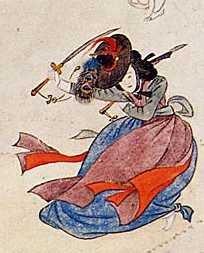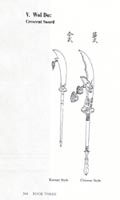
A Japanese sword is one of several types of traditionally made swords from Japan. Bronze swords were made as early as the Yayoi period, though most people generally refer to the curved blades made from the Heian period (794–1185) to the present day when speaking of "Japanese swords". There are many types of Japanese swords that differ by size, shape, field of application and method of manufacture. Some of the more commonly known types of Japanese swords are the uchigatana, tachi, ōdachi, wakizashi, and tantō.
A sword is an edged, bladed weapon intended for manual cutting or thrusting. Its blade, longer than a knife or dagger, is attached to a hilt and can be straight or curved. A thrusting sword tends to have a straighter blade with a pointed tip. A slashing sword is more likely to be curved and to have a sharpened cutting edge on one or both sides of the blade. Many swords are designed for both thrusting and slashing. The precise definition of a sword varies by historical epoch and geographic region.
A tachi is a type of sabre-like traditionally made Japanese sword (nihonto) worn by the samurai class of feudal Japan. Tachi and uchigatana generally differ in length, degree of curvature, and how they were worn when sheathed, the latter depending on the location of the mei (銘), or signature, on the tang. The tachi style of swords preceded the development of the katana, which was not mentioned by name until near the end of the twelfth century. Tachi were the mainstream Japanese swords of the Kotō period between 900 and 1596. Even after the Muromachi period (1336–1573), when katana became the mainstream, tachi were often worn by high-ranking samurai.
This is a list of types of swords.

The jian is a double-edged straight sword used during the last 2,500 years in China. The first Chinese sources that mention the jian date to the 7th century BCE, during the Spring and Autumn period; one of the earliest specimens being the Sword of Goujian. Historical one-handed versions have blades varying from 45 to 80 centimeters in length. The weight of an average sword of 70-centimetre (28-inch) blade-length would be in a range of approximately 700 to 900 grams. There are also larger two-handed versions used for training by many styles of Chinese martial arts.

Dao are single-edged Chinese swords, primarily used for slashing and chopping. They can be straight or curved. The most common form is also known as the Chinese sabre, although those with wider blades are sometimes referred to as Chinese broadswords. In China, the dao is considered one of the four traditional weapons, along with the gun, qiang (spear), and the jian, called in this group "The General of Weapons".

The ōdachi (大太刀) or nodachi is a type of traditionally made Japanese sword used by the samurai class of feudal Japan. The Chinese equivalent of this type of sword in terms of weight and length is the miaodao or the earlier zhanmadao, and the Western battlefield equivalent is the Zweihänder.

The iaitō (居合刀) is a modern metal practice sword, without a cutting edge, used primarily for practicing iaido, a form of Japanese swordsmanship.
Since the 1970s, there has been a revival of traditional or reconstructed methods of swordsmanship based on the Korean sword in the Republic of Korea, supplementing the practice of Kumdo. There are historical sources on which such reconstructions are based, dating to the 17th and 18th centuries, notably the Muyejebo of 1610, its 1759 revision Muyeshinbo, supplemented with 12 additional fighting methods by Prince Sado who originated the term Sip Pal Ki, and the renewed revision of 1790, Muyedobotongji.

Japanese sword mountings are the various housings and associated fittings that hold the blade of a Japanese sword when it is being worn or stored. Koshirae (拵え) refers to the ornate mountings of a Japanese sword used when the sword blade is being worn by its owner, whereas the shirasaya is a plain undecorated wooden mounting composed of a saya and tsuka that the sword blade is stored in when not being used.

The shashka or shasqua is a kind of North Caucasian sabre; a single-edged, single-handed, and guardless backsword. The comparatively subtle curve of a shashka blade puts the weapon midway between a typically curved sabre and a straight sword, effective for both cutting and thrusting.

A kalis is a type of Philippine sword. The kalis has a double-edged blade, which is commonly straight from the tip but wavy near the handle. Kalis exists in several variants, either with a fully straight or fully wavy blade. It is similar to the Javanese keris, but differs in that the kalis is a sword, not a dagger. It is much larger than the keris and has a straight or slightly curved hilt, making it a primarily heavy slashing weapon.
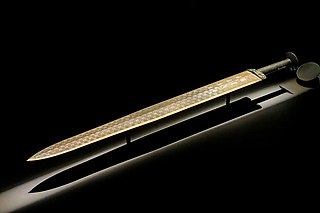
The Sword of Goujian is a tin bronze sword, renowned for its unusual sharpness, intricate design and resistance to tarnish rarely seen in artifacts of similar age. The sword is generally attributed to Goujian, one of the last kings of Yue during the Spring and Autumn period.

Dha is the Burmese word for "knife" and "sword" similar term to daab or darb in Thai language for a single edge sword. The term dha is conventionally used to refer to a wide variety of knives and swords used by many people across Southeast Asia, especially present-day Myanmar (Burma), Thailand, Yunnan, Laos, and Cambodia.
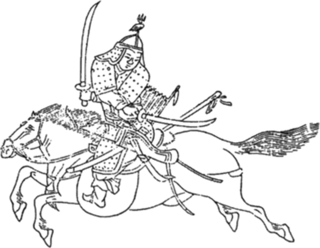
Commissioned in 1790 by King Jeongjo, the Muyedobotongji expanded on the eighteen weapons systems identified in the Muyeshinbo of 1758.
Swords made of iron appear from the Early Iron Age, but do not become widespread before the 8th century BC.
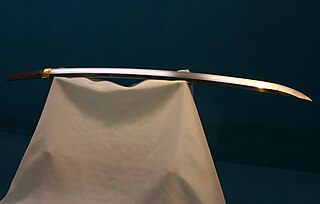
A katana is a Japanese sword characterized by a curved, single-edged blade with a circular or squared guard and long grip to accommodate two hands. Developed later than the tachi, it was used by samurai in feudal Japan and worn with the edge facing upward. Since the Muromachi period, many old tachi were cut from the root and shortened, and the blade at the root was crushed and converted into a katana. The specific term for katana in Japan is uchigatana (打刀) and the term katana (刀) often refers to single-edged swords from around the world.
The Muyesinbo is a Korean martial arts manual published in 1759. The book is a revision of the older Muyejebo, made during the reign of King Youngjo (1724–1776). It adds twelve disciplines or "skills" of both armed and unarmed fighting by Prince Sado to the original six which were descbribed in the Muyejebo. No copies of the Muyesinbo have survived, but its contents can easily be determined by tracing back and comparing the Muyejebo with the later Muyedobotongji.
Jedok geom (Korean: 제독검) or Admiral sword or Commander sword is a sword-skill originating from China and used during the Japanese invasions of Korea during the 16th century.

This is the glossary of Japanese swords, including major terms the casual reader might find useful in understanding articles on Japanese swords. Within definitions, words set in boldface are defined elsewhere in the glossary.



